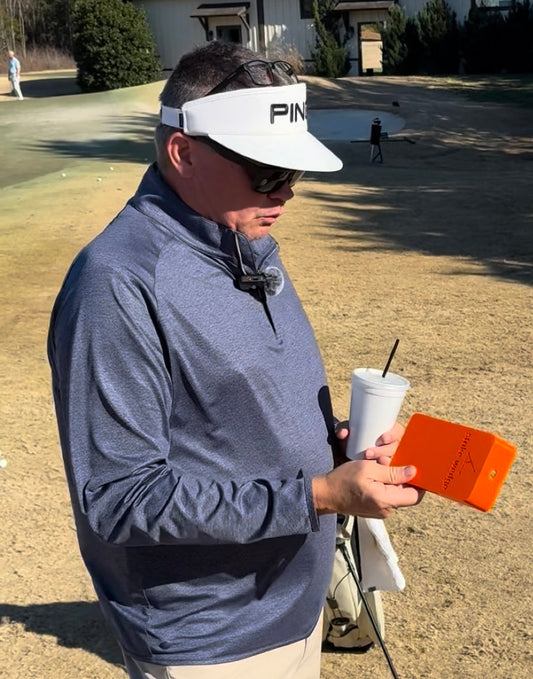The Hitting Mat Epidemic: How Synthetic Mats are Setting Golfers Up for Failure
Share
Golf is a game of precision, where even the smallest miscalculation can ruin a perfectly good shot. Yet, in driving ranges around the world, there’s a silent epidemic holding back golfers of all levels—the synthetic hitting mat. What was designed for convenience and durability is now giving golfers an inflated sense of confidence and security when it comes to their ball striking.
The False Confidence Trap
On a real golf course, every shot tells you the truth. Hit just an inch behind the ball, and you'll pay for it with grass and dirt flying everywhere—and your ball flying nowhere. But on a mat? It’s like playing a rigged game. Even when you make poor contact, the club slides across the surface, and the ball takes off like you’ve nailed it. But you didn’t, and deep down, you know it.
What’s worse, we can’t even call mats a “perfect lie.” They’re beyond perfect. Even if you place the ball on a tee in real grass, you can still fat the shot by hitting behind it. But on a mat, the surface practically guarantees clean contact. Mats disguise fat shots so well that many golfers unknowingly adjust their swings to hit further and further behind the ball just to avoid hitting it thin. And sometimes, if you hit it fat just right, you’ll actually see the ball fly farther than it usually would. Why? Because the reduced spin from the fat contact allows it to carry further.
Golfers learn to manipulate their swing for mats, bringing their low point further back and shallowing their attack angle into the ball. In doing so, they start to develop positive attack angles with their irons—a trait you’d never find on the PGA Tour. In fact, not a single pro has a positive attack angle with their irons. But head to your local driving range, and I’d bet about half the golfers do. So, who’s right? You decide.
The Beginner’s Illusion
When you’re new to golf, the game should build you up gradually, helping you improve step by step. And, at first, the mat seems like a great tool. You get to see the ball fly, feel good about your swing, and maybe even get excited about your progress. You feel like you're doing it, hitting the ball well and on your way to mastering the game.
But then reality hits, quite literally, the moment you step onto the course.
You think you’ve improved, but on the course, it’s a different story. You swing just like you did at the range, but this time, the turf grabs the club, and the ball dribbles off, barely moving. No smooth, reassuring slide here—just cold, hard earth reminding you how far from ‘mastery’ you really are. It’s frustrating, and suddenly, the confidence you built up on the range feels like a cruel joke.
The Crushing Cycle
And so begins the cycle. You go back to the range, trying to regain that sense of control you thought you had. The mat once again flatters you, makes you feel like things are improving. You leave feeling confident and excited, but deep down, you know you haven’t really solved anything. You haven’t faced the real challenge—grass.
Back on the course, it's like a nightmare. The lies are different. The shots are harder. On your very first hole, your ball nestles into a small depression. You try to power through, only to fat the hell out of it. A chunk of earth flies further than the ball. You walk to your next shot, your heart pounding, desperately trying not to repeat the mistake. But now you’re scared to fat it again, and what do you do? You thin it over the green. Everyone else is putting, and you’re scrambling, nerves fully activated.
Now you’re faced with a delicate chip shot—ball sitting down, rough surrounding you, a raised green. Every instinct in your body is telling you to panic. You have no confidence left, no trust in your swing. You try to stay calm, but it’s another fat shot, and the round feels over before it’s even begun. Your confidence has crumbled.
The Short Game Exposed
In some lies, you might be able to get away with this hitting mat approach, but eventually, you’ll face the true test: hitting into the grain from around the green. When your low point is too far back, the odds of blading the ball or laying the sod over it far outweigh your chances of impressing anyone watching. This is where the real pain shows up—your short game. It’s the part of golf where precision matters most, and unfortunately, it’s where we all feel the most vulnerable. The mat may have masked your flaws at the range, but when you step up to a delicate chip shot, the truth comes out.
If you want to fix your game, here’s the reality: learn to chip, learn to hit.
Breaking the Cycle
At this point, what do you do? Go back to the range to chase that false sense of improvement? Or do you break the cycle and finally confront the real issue: learning what a true strike feels like on grass, where precision matters?
The truth is, if you want to improve, you need real feedback. Hitting off mats isn’t the same as hitting off grass. Real golf isn’t played on mats, and until you learn what proper ball-striking feels like on a real surface, you’re stuck in this cycle of false hope and crushing disappointment.





